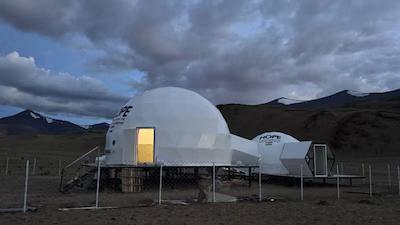
ISRO Sets Up Station in Ladakh to Simulate Life on Moon & Mars
The Indian Space Research Organisation (ISRO) has taken a significant step towards exploring the vastness of space by setting up a unique station in Ladakh’s Tso Kar Valley. The Himalayan Outpost for Planetary Exploration (HOPE) is an innovative facility that will simulate life on the Moon and Mars, allowing scientists to test life-support systems for future lunar and Martian missions. The station is a testament to ISRO’s commitment to pushing the boundaries of space exploration and ensuring India’s presence in the global space arena.
Located in the Tso Kar Valley, HOPE is a unique facility that offers a simulated environment similar to that of the Martian surface. The valley was chosen for its extreme conditions, which are akin to those found on the Red Planet. The area receives high levels of UV radiation, has low atmospheric pressure, and is characterized by extreme cold and saline permafrost. These conditions will allow scientists to test the life-support systems and equipment that will be used on future Mars missions.
The HOPE facility will be occupied by two crew members from August 1 to 10, who will undertake various tests and experiments designed to simulate life on Mars. During their stay, the crew will have to contend with the harsh conditions of the valley, including temperatures as low as -20°C and high levels of UV radiation. The tests will focus on evaluating the effectiveness of life-support systems, including air, water, and food supplies, as well as the ability of equipment to withstand the extreme conditions.
ISRO’s HOPE facility is an important step towards India’s plans to send humans to Mars in the near future. The agency has already made significant progress in its Mars exploration program, with the successful launch of its Mars Orbiter Mission (MOM) in 2013. MOM, also known as Mangalyaan, was India’s first interplanetary mission and has provided valuable insights into the Martian atmosphere and geology.
The HOPE facility is designed to simulate the conditions that astronauts will face on a real Mars mission. The crew members will have to work together to maintain the life-support systems and ensure the success of the mission. The tests will also focus on evaluating the psychological and physical effects of long-duration spaceflight on the human body.
ISRO’s Director, Shri K Sivan, has expressed his excitement about the HOPE facility and its potential to contribute to India’s space exploration program. “The HOPE facility is an innovative step towards testing life-support systems for lunar and Martian missions,” he said. “The experience gained from this mission will be invaluable in preparing for future human missions to Mars and the Moon.”
The HOPE facility is not just a test bed for life-support systems, but also a platform for scientists to conduct research on the effects of extreme conditions on living organisms. The facility will also provide insights into the challenges of long-duration spaceflight and the ways in which humans can adapt to the harsh conditions of space.
In conclusion, ISRO’s HOPE facility in Ladakh’s Tso Kar Valley is a significant milestone in India’s space exploration program. The facility will provide valuable insights into the challenges of life on the Moon and Mars and will help scientists to develop the necessary life-support systems for future human missions. As India continues to push the boundaries of space exploration, the HOPE facility will play a vital role in ensuring the success of its ambitious space program.






